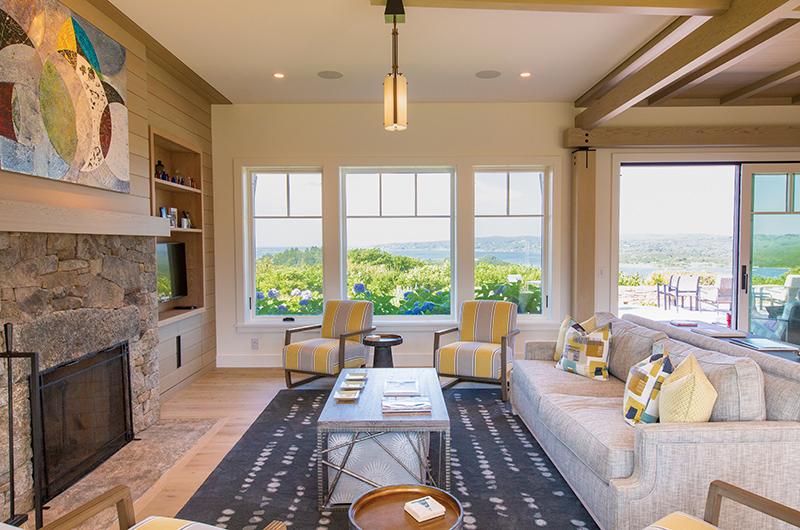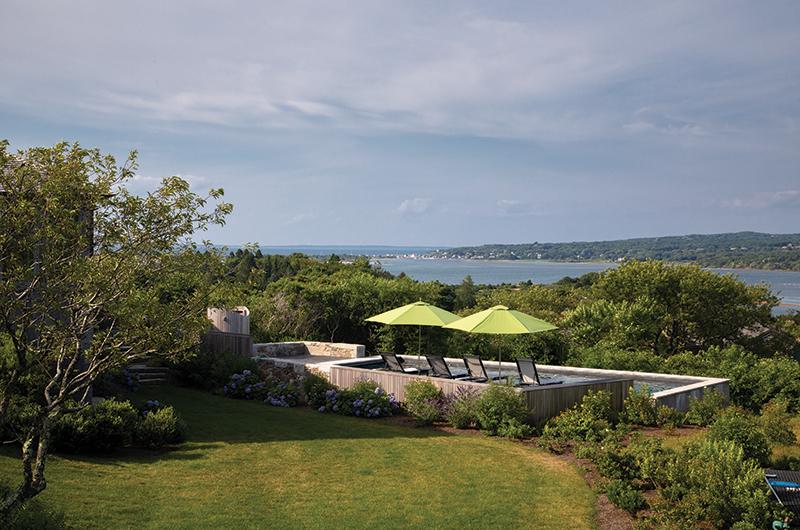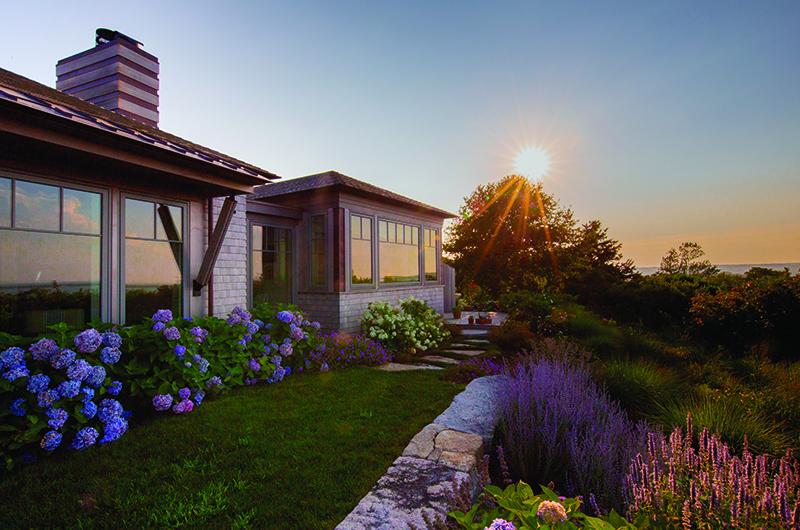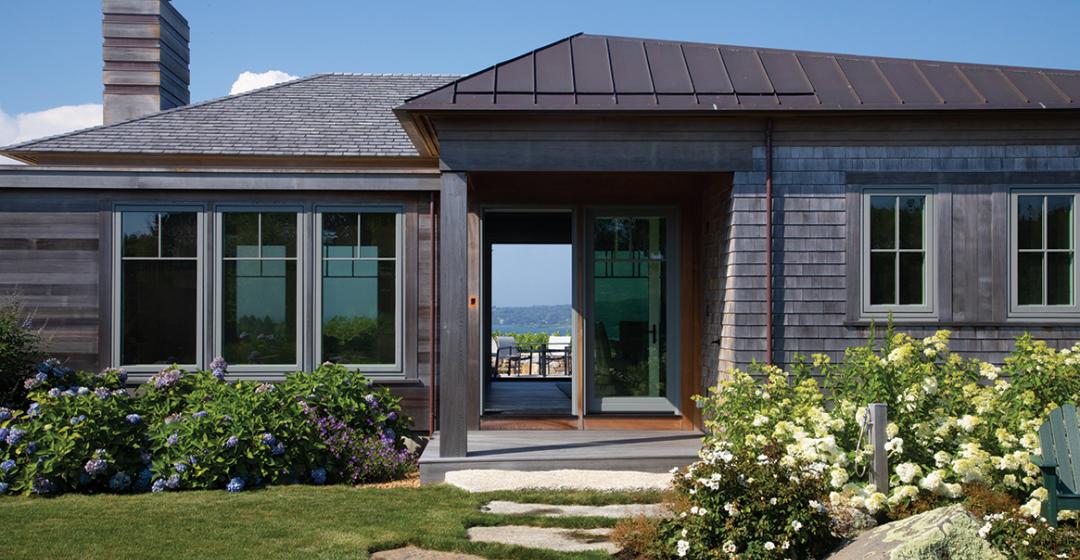Tucked away on Lovey’s Cove in Chilmark is a house that hugs a hill. As you pull down the winding driveway, the residence appears to rest on the horizon. The approach doesn’t reveal much, but even before you open the front door, large windows draw you in, presenting a striking panorama of the water beyond.
Phil Regan, who is a partner at Hutker Architects, was the principal designer of the home, which is owned by a couple from the Washington, D.C., area who purchased the property in 2015 after years of renting various homes on the Island. “Phil wanted the view to be an incredible surprise,” one of the owners said, “and frankly, it is.”
Though the initial inspiration for the house was literally sketched on the back of a napkin one winter night by Regan while having dinner with the owners, there was nothing hasty about the process. Even the purchase was drawn out. The funky cottage on Lovey’s Cove was one of the first places to catch the couple’s attention during their search. But despite the view, the existing house had been on and off the market for varying prices over the years without selling.

“The cottage was older, and it had not been very well maintained,” they recalled. Still, something kept bringing them back to the listing, until it finally became their home in 2015. Their plan all along was to replace the building, but prior to beginning renovations, the couple chose to live in the original cottage for a season or two in order “to develop a greater sense of the Island and property before making any changes.”
Working with Regan, co-project managers Scott McCullough and Anthony Bené, and builder Leo DeSorcy, their primary goal was to create a fully modern home that enhanced the natural features of the property and maintained its history and character. Every window, wall, and angle was chosen with the sun’s position in the sky in mind. For example, the length of the terrace’s overhang balances sunlight and shade throughout the seasons, offering proper shade in the summer and light in the spring. Similarly, materials were selected based on how they would weather into the landscape. Yellow, white, and red cedar were accented by miscellaneous copper touches and corners.
The lines of the home attempt to mirror the hillside, fitting together like parts of a puzzle. Built on an unusual angle, the home moves with the terrain as though it blossomed from the soil over time. “We let the site speak to us,” Regan stated. “Like you picked it up, dropped it, and it fell exactly as it stands today.”
A welcoming interior, filled with light and warmth, complements the understated exterior. Three wings comprise the home: a primary suite, a glowing open-concept living room that leads into a kitchen and dining room, and finally two bedrooms with a family room and guest room. Alcoves nestled throughout the home add a sense of tranquility and privacy while still allowing for expansive views of Menemsha Harbor, Menemsha Pond, Quitsa Pond, and the Atlantic, all of which can be seen from almost anywhere on the grounds. The homeowners’ interior decorator, Irma Reshefsky, curated a modern, uncomplicated living space to reflect the scenery. Oceanic tones make the rooms feel airy and open. Each room has a view, of course, but the twist and turn of the floor plan, combined with the varied nature of the landscape, ensures that each view is unique.

Off to the side is a garage for storage, equipped with an upstairs office area. That building’s angular appearance parallels the main house, which also hugs the contours of the land. Its lean-to roof is covered with solar panels that heat the backyard pool, which itself acts as an accent to the landscape, appearing as if it were another pond. The original cottage was nestled in a cherry grove filled with enormous boulders and stones. Some needed to be rearranged, of course, but landscape architect Kris Horiuchi and stone mason Eben Armer paid close attention to preserving the pastoral feel of the grounds, and Armer brought some of the stones inside to complement the outdoor scenery. Plants were selected and landscaped to appear as if they were native volunteers. Where a tire-track driveway initially circled around the house, there’s now a stone foot-path winding through the yard to the front entrance; it appears as if it has been there all along.
The design’s functionality became apparent during the first phase of the Covid pandemic, when six people lived in the house yet it remained a peaceful escape for the entire family. “The house’s versatility affords total comfortability that we hadn’t hoped for at first,” one of the owners said with a smile.

The owners’ determination to take steps one at a time, and their willingness to entrust their team to do the same, seems to have made for a relatively stress-free process in which all the principals – architect, contractor, and clients – wound up better friends. Regan and DeSorcy, both long-time Islanders with deep roots here, have known each other for more than forty years and have worked on several properties together. “Leo is a man of another century, being such a superb craftsman,” said one of the owners, with obvious affection. “His attention to detail is extraordinary, as is Phil’s. The two make a powerful pair.”
When the homeowners invited Regan to dinner winters ago, they remember exchanging a handshake after he sketched his vision for the cottage on a napkin – a true Islander covenant. Ultimately, they believe, it was the mutual respect and easy rapport between the team and clients that lead to the home’s success. “Usually there would be a facilitator when building a new home,” the homeowner continued, “but we were lucky to have a team that got us.”
Every six to eight weeks during construction, Regan would visit the project to meet with the owners and assess the next steps to be taken, and he still stops by periodically. “Projects are like children,” he said. “Once they leave, you don’t always see them, but you hope they’re well. You check in to see how they’re doing all the time.”
He believes each house is a story, and the project on Lovey’s Cove has been one of his favorites. “Magic was not what we set out for,” said Regan, “but magic is what happened.”





